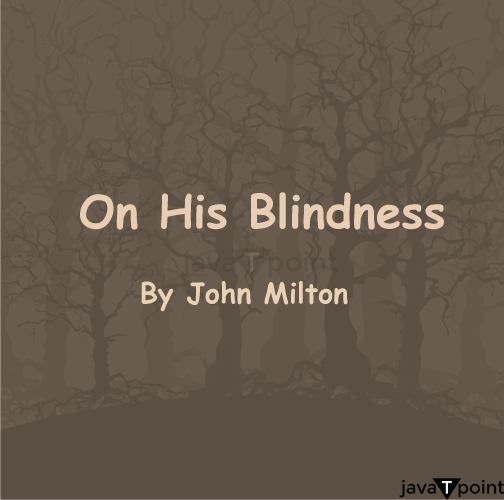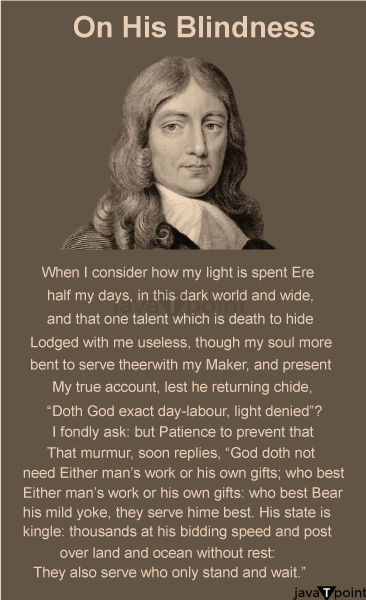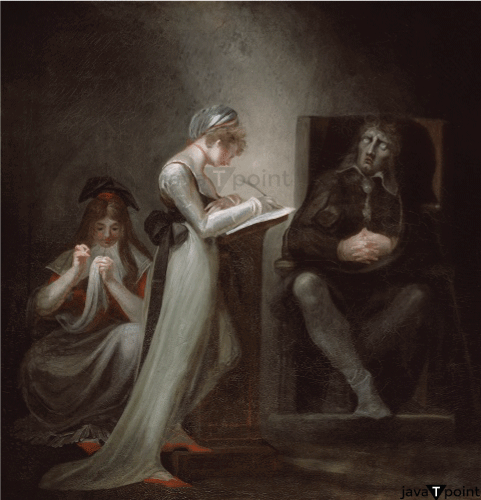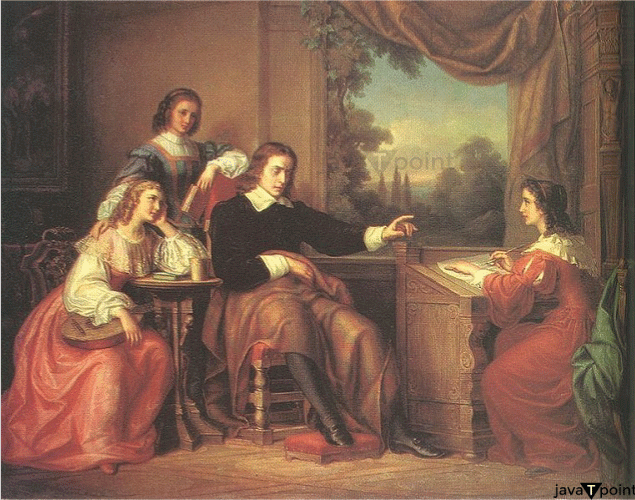On His Blindness: Summary, Theme & AnalysisThe well-known poem "On His Blindness" was penned by English poet John Milton, who lived from 1608 to 1674. The poem occupies a unique place in Milton's body of work because it captures his reflections on his limitations as a servant of God and his difficulties with blindness. "On His Blindness" explores acceptance, faith, and the search for meaning in the face of tragedy. It was written during a time in Milton's life when he rapidly lost his eyesight. 
The poem by Milton is an in-depth investigation of the human condition and the significant effects of physical and spiritual difficulties. He pulls readers into his journey through poetic tropes and vivid imagery, giving readers an understanding of the feelings and thoughts that come with dealing with the loss of a crucial sense like sight. This analysis will examine the organization, topics, and language in "On His Blindness," illuminating its significance and ever-present relevance. If we delve into the poem's depths, we can better grasp Milton's reflections and his search for spiritual insight while facing enormous obstacles. Poem Form and Structure"On His Blindness" is set up like a Petrarchan sonnet, with an octave (eight lines) and a sestet (six lines), as is customary. The Italian poet Petrarch popularized the sonnet form, which is renowned for its concise composition and capacity to explore complex feelings and intellectual concepts inside a constrained space. In "On His Blindness," Milton introduces the main conflict and lays the groundwork for the poem's examination of his battle with blindness. Usually, the lines are broken up into two quatrains with the rhyme pattern ABBAABBA. The poet wrestles with the loss and despair brought on by his blindness in this part as he considers his state. In his darkness, he wonders how he may serve God successfully. Following the octave, the sestet introduces a change in tenor and viewpoint. Milton considers his uncertainties and apprehensions, ultimately finding comfort in his faith in God's compassion and wisdom. The sestet frequently has a rhyme pattern of CDCDCD or CDECDE, which enables Milton to be clear and concise in expressing his ideas and conclusions. The Petrarchan sonnet's structure conveys the internal conflict and reflection going on in Milton's head. Despite the speaker's internal turmoil, the symmetry and balance of the shape give it a feeling of order and control. Following this predetermined format, Milton successfully uses the sonnet's expressive potential to succinctly and forcefully express his feelings and ideas. 
Though the structure of "On His Blindness" properly follows the sonnet form, the poem does not strictly follow the iambic pentameter meter. To establish a natural rhythm that strengthens the emotional effect of his words, Milton uses a variety of metrical patterns throughout the poem. He does this by combining stressed and unstressed syllables. This departure from strict meter enhances the poem's expressive and contemplative tone, which enables a more natural and spontaneous flow of ideas and feelings. Milton uses the structure and form of "On His Blindness" as a Petrarchan sonnet to convey his inner conflicts and philosophical musings. The compact structure of the octave and sestet allows for a short and focused investigation of the speaker's inner anguish, while the variations in meter create a rhythmic and emotional flow to the poem. Milton uses the sonnet form to make his words more powerful and invites the audience on his inner journey. An Overview of the Poem 'On His Blindness'John Milton's autobiographical poem "On His Blindness" is incredibly reflective and explores the poet's difficulties with blindness and his quest for meaning and purpose in the face of hardship. The poem commences with the speaker meditating on his condition of blindness, referring to it as a talent or gift bestowed upon him by God. The speaker laments that because he cannot actively serve God as he sees others doing, his potential is left unutilized and dissatisfied. He doubts whether God values patience and understanding more than He does rigorous, immediate service from His disciples. 
The speaker continues by reflecting on the passage of time and how the day's work ends at dusk. He questions whether his blindness will consign him to an eternity of darkness and whether his days will be barren wastes. The speaker is deeply frustrated and saddened by his failure to reach his potential and serve God the way he wants to. The sestet, however, experiences a change in tone as the poem goes on. The speaker considers God's innate intelligence and wisdom, acknowledging that God does not demand the same level of service from everyone. The speaker takes comfort in the idea that God prefers sincerity and perseverance to hasty action. The poem's concluding lines emphasize the speaker's willingness to accept his situation and reliance on God's divine plan by announcing that people who dutifully bear their hardships will eventually be rewarded in heaven. In essence, "On His Blindness" is a moving examination of the speaker's struggle with blindness personally and his quest for acceptance and understanding on a spiritual level. It emphasizes the conflict between one's limitations and the desire to further a greater good, finally highlighting the significance of having faith, patience, and confidence in God's knowledge and purposes. Motifs and Themes of On His Blindness1. Resignation and Acceptance The speaker's path to acceptance of his circumstance is one of the main topics in "On His Blindness." At first, he battles thoughts of annoyance, sadness, and a sense of wasted potential. However, as the poem continues, there is a change toward resignation and readiness to submit to God's plan. The poem examines the tranquillity of embracing one's situation and the transforming power of acceptance. 2. Struggle on a Personal and Spiritual Level The poem explores the speaker's inner turmoil as he struggles with his physical constraints, the conflict between his desire to serve God, and the physical limitations that prevent him from doing so successfully. This battle highlights the common experience of battling personal struggles and seeking spiritual enlightenment. It transcends the personal world and touches on larger concerns of the human condition. 3. Faith and Reliance on God The poem's major themes throughout are faith and confidence in God. The speaker's misgivings and questions ultimately lead to understanding God's wisdom and the conviction that God prefers honesty and perseverance to hasty action. The poem examines the value of holding onto your faith in the face of hardship and believing in a higher power's plan, even though your limits constrain you. 4. Redemption and Loss The speaker's apparent loss of productivity, usefulness, and capacity to serve God is represented by the loss of sight, which is also the poem's main topic. The poem, however, makes the case that redemption and compensation can be discovered with steadfast endurance and acceptance of one's limits. It explores the idea that there is still room for spiritual development and ultimate fulfilment, even in the face of loss. 
5. Mortality and Time The poem's speaker muses on the fleeting quality of life and the finiteness of human existence as time passes, a reoccurring theme. The coming of night represents the completion of the day's work and reminds us of how little time is left to accomplish their goals. In light of mortality, the poem highlights the value of time, production, and the quest for spiritual fulfilment. 6. Light and Night The poem conveys the speaker's sense of loss and his need for clarity and vision through the contrast between light and darkness. In addition to the literal lack of light, the darkness connected to his blindness also alludes to his sentiments of doubt and hopelessness. Light represents the clarity, direction, and spiritual illumination the speaker is working to reclaim or understand. These themes and motifs come together in "On His Blindness" to examine the human experience that wrestles with boundaries, faith, acceptance, and the quest for spiritual satisfaction. Imagery and LanguageTo communicate the speaker's feelings, introspection, and reflection on his blindness in "On His Blindness," John Milton uses complex language and striking imagery. The poet uses various literary techniques to increase the poem's effect and give the reader an emotional and evocative experience. 1. Metaphorical Expressions Milton uses metaphors frequently to convey the speaker's inner anguish and the poem's larger topics. For instance, blindness is symbolically described as a "talent" or "gift" God bestows, implying that it is a special challenge to be accepted rather than merely a physical condition. The speaker's reflections gain depth and complexity thanks to this metaphorical language. 
2. Sensational Images Milton uses sensory images to provide a rich and multimodal experience despite the speaker's blindness. He makes an emotional impact through senses other than sight. For instance, the poem examines the sense of touch by expressing the speaker's capacity to feel God's "mild yoke" and "gentle hand," as well as references to "inner eyes" that see God's presence. Readers can connect viscerally with the speaker's experience through such imagery. 3. Imaging Techniques Despite the speaker's possible blindness, the poem uses visual imagery to elicit strong mental images and express abstract ideas. As an illustration, the speaker muses on the contrast between light and darkness while expressing his yearning for spiritual insight and clarity through day and night imagery. This imagery improves the reader's understanding of the speaker's struggle. 
4. Biblical and Religious Terminology Milton uses religious and biblical vocabulary to convey the speaker's spiritual journey, keeping with the poem's overtly religious connotations. The poem has a religious and theological dimension due to references to serving God, divine will, and ideas of faith and redemption, which emphasizes the speaker's search for understanding within the context of his faith. 5. Emotional Expression Milton uses emotionally charged language to express the speaker's spectrum of emotions, from irritation and despair to acceptance and trust. Words like "dark world," "talent," "patience," and "reward" elicit a range of emotions and add to the poem's overall emotional richness. With the help of this language, readers can identify with the speaker's difficulties and emotionally engage with the poetry. Milton expertly draws readers into the speaker's interior world through language and images, letting them share his feelings, thoughts, and spiritual journey. The poem's use of metaphorical language and imagery amplifies its themes of acceptance, faith, and personal suffering, leaving the reader with a strong impression. Undertones of Religion and SpiritualityJohn Milton's "On His Blindness" is infused with religious and spiritual themes, reflecting the poet's strong faith and pursuit of theological ideas in the face of personal tragedy. The poem explores the speaker's spiritual development, focusing on his relationship with God, the difficulties he encounters due to his blindness, and the ultimate resolution he finds through trust and surrender to God's purpose. 1. God's Providence The poem makes frequent use of the idea of divine providence. The speaker struggles with the notion that his blindness is a talent or gift that he must use differently as part of God's purpose for him. The speaker's meditation aims to comprehend God's plan and harmonize his aspirations with the divine intent. 2. Obligation and Service The poem examines the speaker's desire to serve God, his uncertainty about the best way to carry out his responsibility, and his worries about his usefulness and productivity. The speaker struggles with the conflict between actively serving God and the limits he feels his blindness has placed on him. This conflict mirrors more overarching theological themes of submission, service, and discovering one's position in the divine scheme. 3. Trust & Faith The speaker's path of faith and confidence in God is shown in "On His Blindness." The speaker initially feels uncertainty, annoyance, and a sense of unrealized potential. But as the poem continues, the speaker's perspective changes, leading to an awareness of God's wisdom and readiness to submit to His divine purpose. The poem emphasizes how crucial it is to hold onto your faith in the face of difficulty and put it in God's direction. 4. Endurance and Patience In light of the speaker's challenges, the poem examines the benefits of tolerance and perseverance. The speaker wonders if God requires urgent and vigorous service but finally finds comfort in believing God appreciates honesty, patience, and unwavering perseverance. This subject reflects that enduring and persevering through trying conditions is frequently necessary for spiritual progress. 5. Biblical References Milton uses biblical allusions throughout the poem, relying on religious imagery and allusions to emphasize the speaker's observations' spiritual content. The poem is set in a religious setting with the themes of darkness and light, serving God, and receiving rewards in heaven, which echoes biblical teachings. These themes encourage readers to think about the spiritual ramifications of the speaker's trip. Milton's beliefs and his investigation of theological concepts are reflected in "On His Blindness's overtones of religion and spirituality. The speaker struggles to reconcile his goals with God's purpose as the poem dives into themes of divine providence, service, faith, and patience. Milton encourages readers to consider their connection with faith, their difficulties, and the possibilities for spiritual growth amid hardship through these subtexts.
Next TopicDry September Summary
|
 For Videos Join Our Youtube Channel: Join Now
For Videos Join Our Youtube Channel: Join Now
Feedback
- Send your Feedback to [email protected]
Help Others, Please Share









